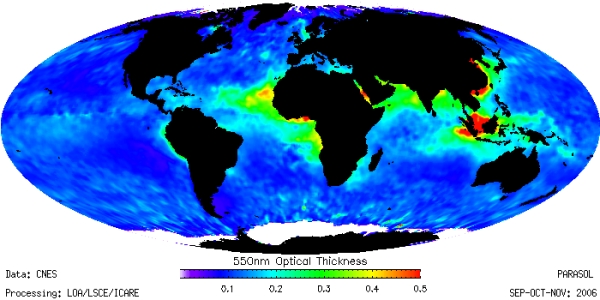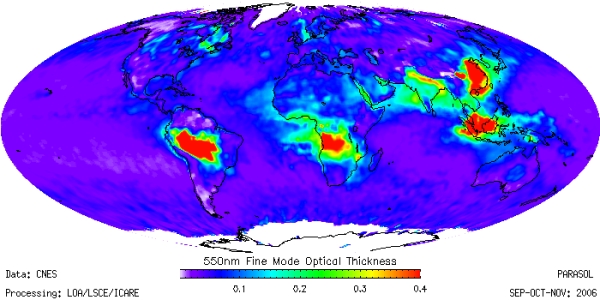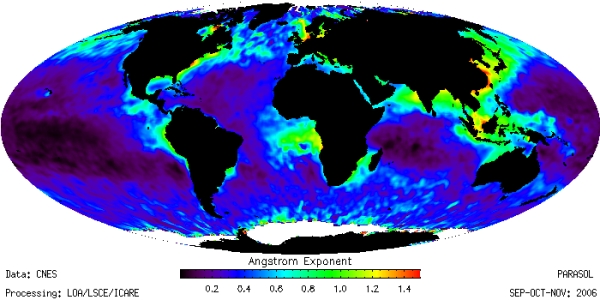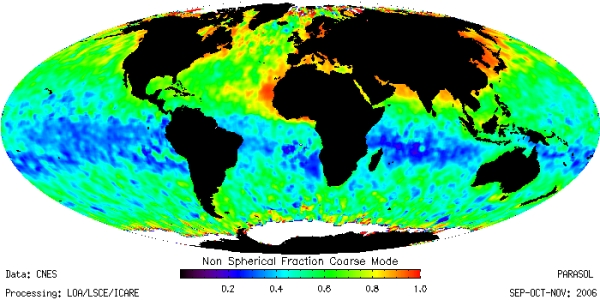POLDER/PARASOL scientific products include the following parameters (Click on a product name to get the product description and a sample image):
|
« Aerosol » products: |
Aerosols Optical Thickness (AOT)
The Aerosols Optical Thickness (AOT) characterizes the aerosols concentration in the atmosphere and depends on the particle characteristics (refractive index, shape, size compared to the wavelength, particle number per unit volume). The inversion scheme is based on the spectral normalized radiances L and the polarized normalized radiances in the 865 and 670 nm channels. It is derived over ocean only because of the unknown surface contribution over land. The characteristics of both aerosol modes (accumulation and coarse) are derived.

The Fine Mode Optical Thickness is the AOT resulting from the fine mode of the aerosols size distribution (particle sizes smaller than about 0.35 micron. It is derived from the polarized radiances. Over land, where the surface contribution to the total radiance is generally large, the inversion scheme uses the polarized radiances in the 865 nm, 670 nm and blue channels. As the largest particles (radius > 0.5 µm) generate low polarization, only the optical characteristics of the accumulation mode are derived. Over ocean, the inversion scheme is based on the spectral normalized radiances L and the polarized normalized radiances in the 865 and 670 nm channels.

Angstrom Exponent
The Angstrom exponent , which relies on the spectral slope of the aerosol optical thickness between 865 and 670 nm, is a simple indicator of the mean particle size (it decreases when the particle size increases).

Non-Sphericity Index for the Coarse Mode
Ratio (AOT of large non-spherical particles)/(AOT of large particles). ID=0 for large aerosols consisting only in spherical particles. ID=1 for large aerosols consisting only in non-spherical particles. Note that the algorithm that generates this parameter requires specific viewing geometry conditions. The angular sampling of POLDER is not continuous. Thus, « valid » pixels for the application of the algorithm are not evenly distributed, which results in the alternance of regions with/without retrievals.

Aerosols over ocean
Aerosols over ocean level 3 product (around 70 Mbytes): L3TOGC (ex: PARASOL/OC3)
The following geophysical parameters are computed for each superpixel (3x3 pixels), from all the level 2 products corresponding to a given month. All these Level 3 parameters are non-directional.
| Parameter | Definition | Unit | Range | Bytes |
|---|---|---|---|---|
| For each decade d=1, 2, 3 | ||||
| N(d) | Number of aerosol estimates | - | 0 - 160 | 1 |
 865(d) 865(d) | Mean aerosol optical thickness at 865 nm | - | 0 - 2.5 | 2 |
 p865(d) p865(d) | Mean aerosol optical thickness of the small mode at 865 nm | - | 0 - 2.5 | 2 |
 (d) (d) | >Mean Angström coefficient, computed from  865(d) and 865(d) and  670(d) 670(d) | - | -0.5 - 2 | 2 |
 p(d) p(d) | Mean Angström coefficient of the small mode, computed from  p865(d) and p865(d) and  p670(d) p670(d) | - | 1 - 3.5 | 2 |
| AI(d) | Mean of aerosol index | - | -0.5 - 3 | 2 |
| For the month | ||||
| Nmens | Number of observations (bounded to 255) | - | 0 - 255 | 1 |
| Nmens_opt | Number of observations with optimal viewing geometry | - | 0 - 255 | 1 |
 865mens 865mens | Mean aerosol optical thickness at 865 nm | - | 0 - 2.5 | 2 |
 p865mens p865mens | Mean aerosol optical thickness of the small mode at 865 nm | - | 0 - 2.5 | 2 |
 mens mens | Mean Angström coefficient, computed from  865(d) and 865(d) and  670(d) 670(d) | - | -0.5 - 2 | 2 |
 pmens pmens | Mean Angström coefficient of the small mode, computed from  p865(d) and p865(d) and  p670(d) p670(d) | - | 1 - 3.5 | 2 |
| AImens | Mean of aerosol index | - | -0.5 - 3 | 2 |
 pp865mens pp865mens | Mean of AOT of small mode at 865 nm, based on measurements with optimal viewing geometry | - | 0 - 2.5 | 2 |
 gs865mens gs865mens | Mean of AOT of spherical large mode at 865 nm, based on measurements with optimal viewing geometry | - | 0 - 2.5 | 2 |
 gns865mens gns865mens | Mean of AOT of non-spherical large mode at 865 nm, based on measurements with optimal viewing geometry | - | 0 - 2.5 | 2 |
 gc865mens gc865mens | Mean of AOT of large mode at 865 nm, based on measurements with optimal viewing geometry | - | 0 - 2.5 | 2 |
| IDmens | Mean relative contribution of non spherical particles to the large mode AOT with optimal viewing geometry | - | 0 - 1 | 1 |
Q 865(k) 865(k) | Quartile of the aerosol optical thickness at 865 nm (k = 1 - 5 for min, first intermediate, median, second intermediate and max value) | - | 0 - 2.5 | 2x5 |
Q p865(k) p865(k) | Quartile of the AOT of the small mode at 865 nm (k = 1 - 5 for min, first intermediate, median, second intermediate and max value) | - | 0 - 2.5 | 2x5 |
f (k) (k) | Normalized frequencies of Angström coefficient (k = 1 - 4): <=0.5 ; 0.5< <=0.5 ; 0.5<  <=1 ; 1< <=1 ; 1<  <=1.5 ; <=1.5 ;  >1.5 >1.5 | - | 0 - 1 | 1x4 |
f p(k) p(k) | Normalized frequencies of small mode Angström coefficient (k = 1 - 4): p <=2 ; 2< p <=2 ; 2<  p <=2.5 ; 2.5< p <=2.5 ; 2.5<  p <=3 ; p <=3 ;  p >3 p >3 | - | 0 - 1 | 1x4 |
| fmp(k) | Normalized frequencies of the small mode refractive index (k = 1 - 3) with optimal viewing geometry: mp <=1.4 ; 1.4< mp <=1.5 ; mp >1.5 | - | 0 - 1 | 1x3 |
| fmg(k) | Normalized frequencies of the large mode refractive index (k = 1 - 3) with optimal viewing geometry: mg <=1.34 ; 1.34< mg <=1.36 ; mg >1.36 | - | 0 - 1 | 1x3 |
| fr(k) | Normalized frequencies of the effective radius (k = 1 - 4): r <=0.7µm ; 0.7µm< r <=1.1µm ; 1.1µm< r <=1.75µm ; r >1.75µm | - | 0 - 1 | 1x4 |
| frp(k) | Normalized frequencies of the small mode effective radius (k = 1 - 4): rp <=0.1µm ; 0.1µm< rp <=0.15µm ; 0.15µm< rp <=0.2µm ; rp >0.2µm | - | 0 - 1 | 1x4 |
